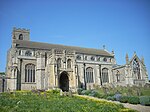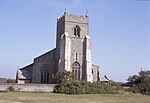Cley Marshes

Cley Marshes is a 176-hectare (430-acre) nature reserve on the North Sea coast of England just outside the village of Cley next the Sea, Norfolk. A reserve since 1926, it is the oldest of the reserves belonging to the Norfolk Wildlife Trust (NWT), which is itself the oldest county Wildlife Trust in the United Kingdom. Cley Marshes protects an area of reed beds, freshwater marsh, pools and wet meadows and is part of the North Norfolk Coast Site of Special Scientific Interest (SSSI), Special Area of Conservation (SAC), Special Protection Area (SPA), and Ramsar Site due to the large numbers of birds it attracts. The reserve is important for some scarce breeding species, such as pied avocets on the islands, and western marsh harriers, Eurasian bitterns and bearded reedlings in the reeds, and is also a major migration stopoff and wintering site. There are also several nationally or locally scarce invertebrates and plants specialised for this coastal habitat. It has five bird hides and an environmentally friendly visitor centre and further expansion is planned through the acquisition of neighbouring land and improvements to visitor facilities. The site has a long history of human occupation, from prehistoric farming to its use as a prisoner of war camp in the Second World War. The reserve attracts large numbers of visitors, contributing significantly to the economy of Cley village. Despite centuries of embankment to reclaim land and protect the village, the marshes have been flooded many times, and the southward march of the coastal shingle bank and encroachment by the sea make it inevitable that the reserve will eventually be lost. New wetlands are being created further inland to compensate for the loss of coastal habitats.
Excerpt from the Wikipedia article Cley Marshes (License: CC BY-SA 3.0, Authors, Images).Cley Marshes
Hill Top, North Norfolk Cley Next The Sea
Geographical coordinates (GPS) Address External links Nearby Places Show on map
Geographical coordinates (GPS)
| Latitude | Longitude |
|---|---|
| N 52.959 ° | E 1.056 ° |
Address
Cley Marshes
Hill Top
NR25 7SE North Norfolk, Cley Next The Sea
England, United Kingdom
Open on Google Maps










